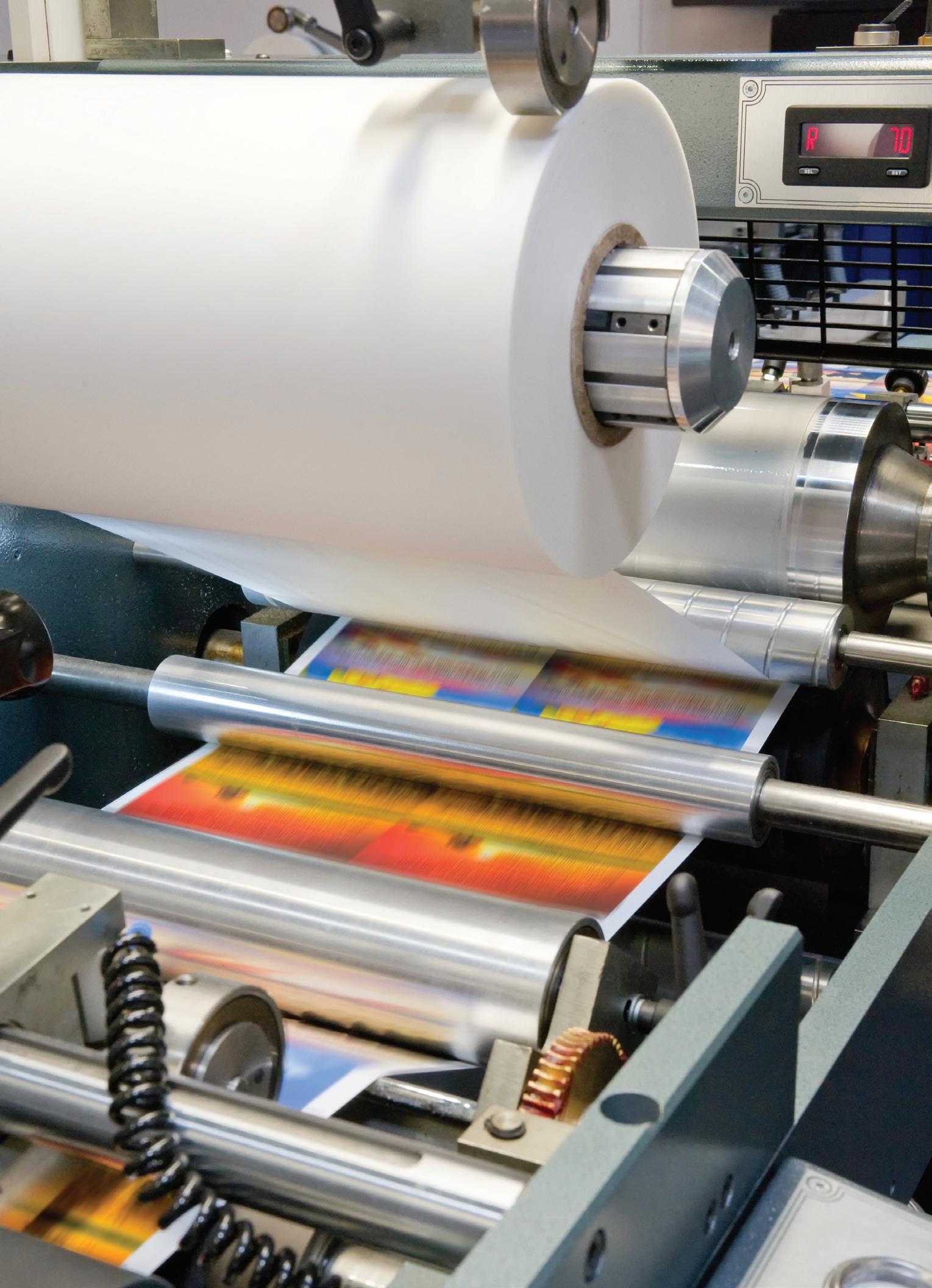ENGAGING MARKETING MINDS





When it comes to printing, we don’t just meet expectations; we shatter them. Our commitment to quality has earned us many awards. Most recently we were awarded 24 Print Excellence Awards from Graphic Media Alliance. We are proud to be recognized as a leader in the industry.
We’re not just a printer, we’re your winning partner.
ope is a beautiful thing in life. It is also a fantastic strategy in today’s marketing world. As we navigate through challenging times, hope emerges not just as a fleeting feeling but as a cornerstone of success. As you know, we marketers play a crucial role in shaping perceptions and experiences. By infusing hope in your strategies, you don’t just promote products or services, you contribute to a more optimistic worldview. It’s about ensuring that every marketing effort exudes a vibe of hope, touching lives in meaningful ways.
Instilling hope in marketing campaigns is a powerful strategy to resonate with the target market and create a lasting impact. By using positive messaging, uplifting stories about your clients, and inspirational visuals, you can instill a sense of hope in your audience. With a focus on hope, you demonstrate the empathy that can set your brand apart.
Some say “Hope is not a strategy.” And hoping for results without effort is a lost cause. Instilling hope in others, however, can never be a bad thing. By integrating hopeful strategies into your campaigns, you not only enhance brand perception but also deepen customer engagement and loyalty.
So, use your campaigns to paint a picture of a better future that your product or service can help achieve. This forward-looking perspective can be very inspiring and hopeful. Additionally, you can build trust by being authentic and reliable. When consumers trust a brand, they are more likely to associate it with positive outcomes and feel hopeful about their engagement with it.
We are hopeful that you love this issue. Our cover story, “The Evolution of B2B Marketing,” is an insightful piece that explores the dynamic landscape of B2B marketing. As it increasingly mirrors B2C tactics, staying abreast of the latest trends is crucial. In our second feature, “Building Bonds - The Art of Relationship-Building Through Print,” we highlight how print plays a pivotal role in building stronger relationships and understanding business needs. And our exclusive Q&A with Chris Kocek, the founder and CEO of Gallant Branding, provides advice on building brands for a better world.
As marketers and brand builders, our mission extends beyond selling— it’s about instilling hope and making a positive impact. We hope this issue inspires you to see the power of marketing through a lens of optimism and potential.
Warmest wishes,
 Diana Renner Publisher
Diana Renner Publisher

B2B vs. B2C Marketing
02 Cover Story The Evolution
06 Feature Building Bonds
10 Tactics Strategies You Can Use
12 On the Record with Chris Kocek
“BY INTEGRATING HOPEFUL STRATEGIES INTO YOUR CAMPAIGNS, YOU NOT ONLY ENHANCE BRAND PERCEPTION BUT ALSO DEEPEN CUSTOMER ENGAGEMENT AND LOYALTY.”
Publisher Diana Renner
The Noodle is published bimonthly by Think Patented, ©24 All rights reserved.
For more information, contact ThinkPatented.com 937 353 2299
Production Notes
This issue features White Neenah Pearl Cover 105 lb on the cover, EuroArt Gloss Text 80 lb text pages. The insert is Cougar® Smooth Cover 80 lb. All are printed on an HP Indigo 100K Digital Press.

WE DON’T GO THROUGH PART OF OUR DAY AS A B2B TARGET AND THEN PART OF OUR DAY AS A B2C TARGET. RATHER,

In one of the chapters from their book, “Winning Through Platforms: How to Succeed When Every Competitor Has One,” Ted Moser and Omar Akhtar discuss the strategy of “Brands Get Brains.” The authors detail how marketers can design the customer experience via artificial intelligence (AI) by incorporating machine vision, semantic analysis, machine learning, content generation, etc.
In a telling sign of where marketing is heading today, Moser and Akhtar say that the customer experience design of the B2B marketer must go beyond “thinking” to incorporating sensing, feeling, guiding and acting. How B2B marketers use brand portfolio strategies to point the customer to where intelligence can be found is how they will elevate a customer’s personal platform experience and transform their enterprise and operations to drive superior performance. AI integration. Hyper-personalization. Immersive experiences. These are a few of the buzzwords driving the future of B2B marketing. As today’s brands continue to rely on data-driven insights to tailor their messaging and strategies, AI and machine learning will play pivotal roles in
automating processes, predicting buyer behaviors and enabling real-time adjustments.
To keep up, B2B marketers and sales teams will have to put a priority on agility and adaptability, meaning they will have to embrace emerging tech and invest in robust analytics more than ever before to stay in step with evolving customer expectations.
“Both B2C and B2B clients want to know how to use generative AI to add value to their customer’s journeys in trustworthy ways,” says Moser, Senior Partner at growth and transformation consulting firm Prophet Consulting. “That means finding steps in the customer journey where generative AI adds real value, training the AI on trustworthy data sets, and safeguarding against generative AI’s

I PAY ATTENTION EVERY DAY TO WHAT’S HAPPENING OUT THERE. WE HAVE A STRONG POSITION IN THAT WE SEE WHAT WORKS ACROSS A DIVERSE SET OF COMPANIES: B2B, B2C, BIG, SMALL, STARTUPS, WELL-ESTABLISHED BRANDS, ETC.”
— ROBERT BRILL, CEO, BRILL MEDIAability to extrapolate beyond what is factually true.”
In a time when B2C marketers can offer their B2B counterparts insights on creating emotionally compelling narratives and enhancing customer experiences, B2B marketers are paying attention. The ability to see how B2C marketers leverage diverse communication channels and embrace creativity is helping brands explore innovative ways to engage their audiences.
Chip House, CMO of Insightly CRM, says AI-based strategies will continue to make their presence known moving forward as more marketers use them to support the accelerated creation of graphics, video and content. This will impact all channels, particularly web and digital, for B2C and B2B marketers alike. In addition, as Google, Apple and others phase out third-party cookie tracking, brands will need to rely increasingly on first-party data. That means capturing and using first-party data will be increasingly important for B2C and B2B brands.
“With AI, we’ve begun to use it as a ‘co-pilot’ of sorts as we plan, outline and develop content,” House says. “We’ve migrated our SEO pages and blogs to be co-written with AI—where AI helps us with the initial outlining. The approach has made us more efficient and increased our content output. Also, we’re leveraging our internal CRM data on each customer to better target them for potential upsell opportunities based on what they own, the size of their company and their role.”
House believes that by moving through the world as a consumer and a marketer, it is easier to observe and learn from both sides. “We don’t go through part of our day as a B2B target and then part of our day as a B2C target. Rather, we move through our day as a person wearing different hats at differing times. If I see a great ad in my social feed, it doesn’t matter if it is B2B or B2C; it’s just a great ad that can inspire.”
Robert Brill has been ingrained in the advertising world for the past 20-plus years. As the CEO of Brill Media, he has had a firsthand look at the ever-evolving marketing landscape, on both sides. With a business geared toward precision advertising for business growth, Brill Media focuses on content creation and amplification, paid media, SEO and podcast appearances.
Working with a host of clients, including LinkedIn, Foursquare, GroundTruth, and others, Brill has a keen eye on the changes rumbling through the marketing landscape. “I pay attention every day to what’s happening out there. We have a strong position in that we see what works across a diverse set of companies: B2B, B2C, big, small, startups, well-established brands, etc. So, we take the best of what works and do more of it.”
One of the areas where B2B marketers are following suit with B2C is in the influencer area. Brill says influencers are becoming just as important for B2B strategies. “Both types of businesses should be putting creative iteration at the forefront of their marketing activities to power campaigns in 2024.”
As B2B and B2C marketers move headstrong into 2024, staying in step with evolving trends and techniques will not be a matter of keeping up, but staying ahead. For both, aligning their strategies with their sales teams will be the difference in an increasingly evolving and sometimes finicky marketing landscape.
Whether you aim to cultivate brand loyalty in a B2C market or establish reliability and competence in a B2B one, there are differences in the approach you take. Here, the Forbes Communications Council shows some of the differences.
B2B and B2C brands utilize distinct marketing strategies and approaches to effectively reach target customers, and promote products or services. B2B typically emphasizes forging long-lasting relationships, delivering specialized solutions and establishing business as a trusted industry expert, while the B2C process is simpler and faster.
With B2B sales, there are multiple stakeholders and decision-makers, while B2C often just is an individual targeted with messages that evoke emotions, craft persuasive narratives and showcase direct benefits.
B2B and B2C sales approaches involve different stages, timelines and interactions which impact the speed and overall efficacy of the sales process. For B2B sales, the process tends to be more extensive, involving extended efforts such as networking and building relationships before a sale is ever made.
The B2C cycle is more direct and uncomplicated. The process involves less need for direct relationshipbuilding and more reliance on brand awareness, advertising and digital strategies that inspire immediate purchases.
In the B2B space, the focus is on customer satisfaction. Brands often have limited customers in the early stages, making it crucial to prioritize needs and maintain satisfaction. Direct communication with customers is more common in B2B, allowing for a deeper understanding of their pain points.
The B2C space must address a wide range of customer problems and requests as it scales. With a larger customer base, it becomes more challenging to address every individual need. Prioritization becomes crucial.


ne of Motif Brands’ clients was opening a speakeasy and wanted to raise awareness. Specializing in creating a tasteful experience with an emphasis on service that strives to educate patrons in the art of mixology, the hidden gem needed a splash to announce its arrival. While the group had planned to invest in a social presence, it wanted to blanket the scene of the local food and tourism magazines as well. The plan was to secure a series of full-page ads in the magazines that could show off the unique experience and impending exclusivity that came with the speakeasy. Full pages enveloped in black featuring text that read, “Some secrets must be shared” enticed from the pages, with the speakeasy’s logo appearing subtly in the footer.
As Reilly Newman, Motif Brands’ founder and Chief Strategist, would say later, print was always the way to generate buzz. The dark pages intrigued readers (future customers) as they flipped through the magazine. “It worked like a charm and said a lot about the brand in a very simple way. The beautiful thing about print is that you can somewhat predict the behavior of the reader. They are flipping a page, scanning a certain way, sitting, etc., so you can use this to your advantage. Unlike digital, where there are far more distractions and variables.”
Motif Brands is one of a growing contingent of marketers that continue to view print as the best way to not only grab an audience’s attention, but offer a tangible and physical presence that can build audiences. Direct mail. Brochures. Flyers. Magazines, Postcards. When someone intimately engages with print, they are engaging with their senses in a way digital can never touch.
“I believe print plays a crucial role in the total brand experience, especially in today’s digital era,” Newman says. “This role can be the furthering of value with relevant messaging that focuses on the ideal audience. It can be used to drill down further in more local placements that are geographically focused and take into consideration the specific psychographic who looks at a printed piece.”
Newman believes that the over-saturation of digital and the white noise continues to exhaust today’s consumers. The onslaught creates frustration and overall fatigue, which is forcing brands to reconsider how they imagine their brands being associated with such emotions. “The brand association must be accounted for just as if collaborating with an influencer. Print will continue to

USED EFFECTIVELY AND IN A TARGETED, STRATEGIC MANNER, PRINT CAN BE VERY EFFECTIVE, NOT AS A MAGIC BULLET, BUT AS A COMPLEMENT TO OTHER ACTIVITIES AND RELATIONSHIP-BUILDING.”
— DINA WASMER, PRESIDENT & CEO, INCITE CREATIVE
play a role as it is where the consumer has space to breathe. Just as Restoration Hardware sends out a beautiful booklet of their products, it not only presents well, but reflects the brand in a great light.”
Thirty-plus years into the marketing game, and Dina Wasmer admits to having scores of stories about how she has seen the print and digital revolution play out. Her first “real
job” was doing paste-up for a newspaper, taking short stints to stare into her first computer, which looked like a Zenith TV from the ’50s.
Wasmer’s agency, Incite Creative, specializes in market research, digital marketing, print, and everything and anything in between. And while print tends to be the last channel on many of her clients’ minds, she views the quandary more of it being something they know they can count on, whereas the digital world is ever-changing.
“We recommend a blend of both offline (print) and online (digital) as part of an omnichannel marketing and advertising strategy,” says Wasmer, Incite’s founder, President and CEO. “Granted, the percentage is usually more of a 30/70 split, give or take, but print is not dead. Used effectively and in a targeted, strategic manner, print can be very effective, not as a magic bullet, but as a complement to other activities and relationship-building.”
For example, Incite’s inbound marketing platform includes downloadable lead magnets on a website that are gated. When users hit the website, they see valuable information, fill out a form and gain access to a checklist, ebook, etc. These same content pieces are printed out and in the hands of every sales rep to distribute at networking events, trade shows, and to use as “foot in the door” pieces or leave behinds.
And while brochures still have a place in this equation, Wasmer says they need to be targeted and personalized. “Gone are the days of offset printing 5,000 or 50,000 of one version. Digital printing allows for variable data and minimal quantities that are cost-effective and have a higher ROI.”
Incite Creative also has found relationship-building success with drip campaign direct mail pieces. Geo-targeted and done as one of the “seven touches,” the pieces are a sustainable way to nurture prospects through the customer journey with incentives and offers. The home run is when they are complemented with a clear offer and CTA that drives traffic to the website or in-store.
“We also use digitally printed packaging as part of the sales and retention strategy,”

Wasmer says. “Why send a plain brown corrugated box for a lot of money when you can send a branded box that is custom designed, includes a QR code CTA to your website landing page and cuts through and has staying power? This is a great example of staying power. If it’s made of sturdy material, recipients will keep it and/or repurpose it. That’s the goal—to stay top of mind with prospects until they’re ready to buy, and stay sticky with customers so they
continue to be loyal.”
In a time when digital exhaustion is severely limiting interpersonal interactions, finding more ways to build relationships
through the tactile nature of print is growing—and creating a level of trust, understanding and bonding between sender and recipient that is hard to match.
I BELIEVE PRINT PLAYS A CRUCIAL ROLE IN THE TOTAL BRAND EXPERIENCE, ESPECIALLY IN TODAY’S DIGITAL ERA. THIS ROLE CAN BE THE FURTHERING OF VALUE WITH RELEVANT MESSAGING THAT FOCUSES ON THE IDEAL AUDIENCE.”— REILLY NEWMAN, FOUNDER & CHIEF STRATEGIST, MOTIF BRANDS
We get it—everything, anything digital, and so on. But when it comes to how you engage with your consumers, the traditional approach still works. For example, according to the “2023 State of Direct Mail: Consumer Insights” report by Lob and Comperemedia, 64% of consumers say direct mail has inspired them to take action such as visiting a website, heading to a physical location or making a purchase. Marketers also cite the effectiveness of direct mail, with 74% saying it continues to deliver the highest response, conversion, and ROI of any channel they use. Here’s a look at how recipients engage with direct mail: visit the brand’s website


Mention Generative AI and watch the heads spin. It’s available. It’s disruptive. And today’s marketers are using it. According to “B2B Content Marketing Benchmarks, Budgets, and Trends: Outlook for 2024” by MarketingProfs and Brightspot, 72% use the tool for things like content creation and management. And while AI will dominate the discussions of content marketing in 2024, a lack of guidelines still is deterring some from jumping in, with 36% citing accuracy concerns and 22% wary of copyright concerns. Following is how some B2B content marketers are using AI tools on everyday duties:
51% BRAINSTORM NEW TOPICS
45% RESEARCH HEADLINES AND KEYWORDS
45% WRITE DRAFTS
23% OUTLINE ASSIGNMENTS
20% PROOFREAD
11% GENERATE GRAPHICS
5% ............ CREATE AUDIO
5% CREATE VIDEO
There is no denying that value content adds to your sales strategy. According to the “Content to Conversion: Decoding the B2B Buyer Journey” study by Pavilion and Kickstand, 92% of B2B buyers say it is a critical factor in differentiating between competing vendors or service providers. In addition, 55% who made purchase decisions based on the content say they’ve added a company to their consideration set based on said content. Here’s a snapshot of why content matters:
➤ 64% say content has led them to request a demo
➤ 86% say content has accelerated their purchase decisions and has led them to request a demo
➤ 49% say content has led them to recommend a company

A brand’s voice should be a beacon of clarity, not a source of confusion. It begins with a unified commitment to valuing substance over superficiality.”
— Omnia Strategy Group CEO Jessica Marie on why B2B marketers need to ditch jargon-filled content
What specific data points or trends are needed to understand the intersection between consumer behavior and cultural shifts?
It depends on the category, but it all begins with noticing a particular consumer behavior or attitude or complaint—e.g., on social media or another customer feedback channel— and asking, “Why is this behavior happening in the first place?” For observation to turn into an innovation, sometimes you need time and other cultural events to occur.
How can brands merge qualitative observations with quantitative data to identify these patterns?
Brands have to constantly be on the lookout for these kinds of qualitative observations in the first place. It can begin with personal, lived experiences or it can be based on social media chatter, customer feedback via email or even conversations with friends and family. Once you have compiled a list of complaints and pain points, you have to use additional quantitative methods to see if these issues are isolated or much more widespread.
What methods can be used to contextualize data findings within the broader framework of human truths and values?
There are some human truths or experiences that don’t necessarily have a hidden business model waiting to be invented. There are many customer complaints that don’t have easy or profitable solutions. So you have to look very carefully at each problem or complaint and then see if it is statistically significant and if it can be solved profitably.
OUR CONVERSATION WITH BRANDING EXPERT AND AUTHOR CHRIS KOCEK
In his latest book, “Any Insights Yet? Connect the Dots. Create New Categories. Transform Your Business,” Chris Kocek is on a mission. The goal of the founder and CEO of creative branding firm Gallant Branding was as easy as it was daunting: Create a blueprint that can help brands get to higher ground.
The key, as Kocek has spent a career unraveling, is in the insight-building process. Kocek has worked closely with scores of companies on brand overhauls, new product launches and data-driven campaigns. His book is a testament to the factfinding quest every brand sets out on to carve out the niche. Chock full of real-world examples from leading brands and award-winning campaigns, “Any Insights Yet?” outlines the exhilarating step-by-step process for connecting the dots between data, observations and human truths.

Kocek’s resume’ is an archive of his nationally recognized work with iconic brands and highly respected nonprofits, including AARP, Monster.com, Lowe’s Home Improvement, Hyatt Hotels, Ace Hardware, John Deere, and The Christopher and Dana Reeve Foundation. We sat down with him to get his thoughts on the power of data.
Once you’ve identified the problem or unmet need, there are three methods you can use to see how much traction that problem is getting in the culture. Set up a news alert around key terms related to the issue you want to track. Monitor social media, especially among the groups of people who are affected by the issue. Conduct focus groups and/or surveys among the target audience.
How can brands analyze the gaps between stated preferences (through surveys or interviews) and observed behavior to identify and cultivate their communities?
With each piece of customer feedback or each observed complaint, the brand has to take a step back and ask, “What’s really going on here?” Sometimes the customer desire or the customer complaint doesn’t lead to a simple binary problem-solution dynamic.
The Lay’s “Do Us a Flavor” campaign
is a great example of this. In most product R&D surveys, the way they’re traditionally done, most people would probably reject unusual potato chip flavors like Wasabi or Tikka Masala or New England Lobster Roll. Most brands would say, “There’s no opportunity for those kinds of flavors. It’s too risky.”
But Lay’s knew something else about flavor that they could leverage. They knew from other surveys and social media monitoring that new flavors get people talking. Unusual flavors can often spark an incredible amount of debate on social media, which can be a good thing if effectively harnessed.
So rather than risk their budgets on traditional product launches, they turned the entire process of flavor innovation into a public competition, which built a community of chip and flavor enthusiasts debating the merits of one flavor versus another, leading to far more impressions than a traditional ad campaign and product rollout could

have ever generated.
Sometimes, you have to look at the data in a new light and pair it with another, potentially counterintuitive data point, and then be willing to flip traditional processes upside down to get to a new place.
What role does technology play?
Technology plays a huge role in the insight-building process. The most important thing any brand can do is develop effective real-time feedback loops, especially with a core group of consumers (aka loyal ambassadors). If you can get those customers to log in regularly to a back-end platform and share their thoughts via text, pictures, and short videos, that’s worth its weight in gold.
That said, you have to also make sure you’re giving them the right prompts and asking the right questions. You don’t just want to ask them what they think about your product or potential
innovation. You also want to understand what else is going on in their lives—what trends are they keeping track of, what kinds of stresses are they feeling on a daily basis.
The most important thing to remember is it’s not just about you; it’s about them. Creating the right feedback loop with the right customers can pay 10X the investment.
How can brands create a multidisciplinary approach, involving experts from various fields, to integrate insights into product development or marketing strategies?
It begins by recognizing that insights and innovation are not owned by one department. In order to connect the dots between data points and observations and trends and human truths, you need to connect the dots between your departments as well.
Sometimes you even need to reach
out to experts beyond your own organization. You need to connect customer feedback channels (email, online reviews, social media platforms, and in-person intercepts) with the people in marketing and sales and product innovation.
Instead of shying away from customer complaints, you need to be brave enough to hear people out and harness those frustrations, turning frustration into innovation and new campaign activations.
That’s exactly what Domino’s Pizza did in 2009 when they heard complaints that their pizza tasted more like the box than pizza. Rather than hide from those challenges, they tackled them head on by rebuilding their recipes from the ground up.
In other words, sometimes you need to take a close look in the mirror and be willing to do the hard work of breaking yourself down in order to build yourself back up.

